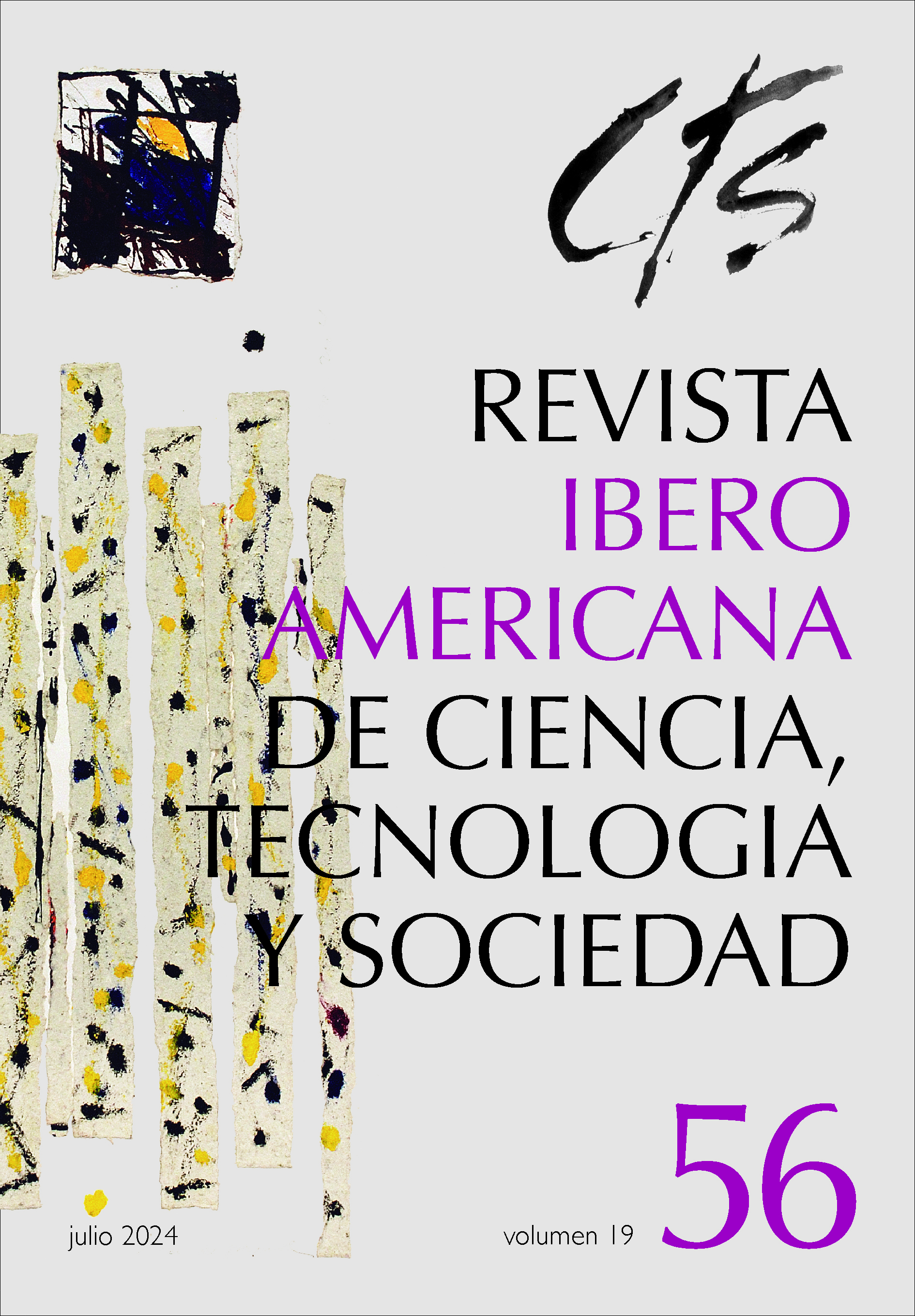Gender and Science Communication
Reflections from a Decade of Analysis at CSIC
DOI:
https://doi.org/10.52712/issn.1850-0013-551Keywords:
scientific culture, disclosure, research centers, scientific and technical staff, genderAbstract
This article examines the involvement of the scientific and technical staff of the Spanish National Research Council (CSIC, due to its initials in Spanish) in public engagement activities over the last decade, with particular attention to the gender perspective. Through a system of indicators specifically developed for the CSIC, the commitment and role of the staff involved in these activities is analyzed, providing an insight into the gender dynamics. The data reveal an increase over the years in overall involvement, for both men and women, with women being predominantly associated with management, organization, and coordination roles in public engagement activities in a proportion of 70-30%, while a balanced presence between sexes is observed in the general participation of personnel in dissemination activities. This result requires further analysis to delve into degree of participation, and responsibilities, as well as to better understand the differences that exist between institutes, centers, and units.
Downloads
References
Alonso-Flores, F. J. & Moreno-Castro, C. (2018). Does science communication enhance researcher impact? A survey among scientists at Spanish universities. Journal of Education and Social Policy, 5(2), 34-44. Recuperado de: http://jespnet.com/journals/Vol_5_No_2_June_2018/5.pdf.
Ambruster-Domeyer, H., Hermansson, K. & Modeer, C. (2011). Samverkan-Public Engagement. International review, analysis and proposals on indicators for measuring public engagement. Estocolmo: VA Report.
Asociación Española de Comunicación Científica (2016). Selfi de la comunicación científica en España. Recuperado de: https://www.aecomunicacioncientifica.org/wp-content/uploads/Selfi-de-la-comunicacion-cientifica-en-Espana.pdf.
BOE (2022). Ley 17/2022, de 5 de septiembre, por la que se modifica la Ley 14/2011, de 1 de junio, de la Ciencia, la Tecnología y la Innovación. Recuperado de: https://www.boe.es/buscar/act.php?id=BOE-A-2022-14581.
BOE (2023). Orden PCM/829/2023, de 20 de julio, por la que se aprueba el Contrato de Gestión de la Agencia Estatal Consejo Superior de Investigaciones Científicas para el periodo 2023-2026. Recuperado de: https://www.boe.es/diario_boe/txt.php?id=BOE-A-2023-16872.
Cámara Hurtado, M. & López Cerezo, J. A. (2008). Dimensiones políticas de la cultura científica. En J. A. López Cerezo & F. J. Gómez González (Eds.), Apropiación social de la ciencia (63-89). Madrid: Biblioteca Nueva.
Cámara Hurtado, M., Muñoz van den Eynde, A. & López Cerezo, J. A. (2018). Attitudes towards science among Spanish citizens: The case of critical engagers. Public Understanding of Science, 27(6), 690-707.
Comisión de Mujeres y Ciencia del CSIC (2023). Informe Mujeres Investigadoras 2023. CSIC. DOI: https://doi.org/10.20350/digitalCSIC/15338.
Consejo Superior de Investigaciones Científicas (2023). Memoria anual del CSIC, 2022. Recuperado de: http://hdl.handle.net/10261/332727.
Consejo Superior de Investigaciones Científicas (s/f). Página web: Comisión de mujeres y ciencia. Recuperado de: https://www.csic.es/es/el-csic/ciencia-en-igualdad/comision-de-mujeres-y-ciencia.
Ecklund, E. H., James, S. A. & Lincoln, A. E. (2012). How academic biologists and physicists view science outreach. PloS one, 7(5), e36240. DOI: https://doi.org/10.1371/journal.pone.0036240.
Fundación Española para la Ciencia y la Tecnología (2015). UCC+i Origen y evolución (2007 - 2014). Madrid: Fundación Española para la Ciencia y la Tecnología. Recuperado de: http://www.fecyt.es/es/publicacion/ucci-origen-y-evolucion-2007-2014.
Fundación Española para la Ciencia y la Tecnología (2021). Libro blanco de las Unidades de Cultura Científica y de la Innovación (UCC+I). Madrid: Fundación Española para la Ciencia y la Tecnología. Recuperado de: https://www.fecyt.es/es/publicacion/libro-blanco-de-las-unidades-de-cultura-cientifica-y-de-la-innovacion-ucci-0.
Fundación Española para la Ciencia y la Tecnología (2022). Indicadores de actividad en cultura científica en España 2015 - 2019. Madrid: FECYT. Recuperado de: https://www.fecyt.es/es/publicacion/indicadores-de-actividad-en-cultura-cientifica-en-espana-2015-2019.
Ferrando González, L., Morera Cuesta, R., Pérez del Val, J. & Tigeras Sánchez, P. (2022). Análisis de indicadores para el fomento de la Cultura Científica: una década de actividad en el CSIC. Arbor, 198(805), a667. DOI: https://doi.org/10.3989/arbor.2022.805015.
Jensen, E. & Gerber, A. (2020). Evidence-based science communication. Front. Commun, 4(78). DOI: https://doi.org/10.3389/fcomm.2019.00078.
Jensen, P. (2011). A statistical picture of popularization activities and their evolutions in France. Public Understanding of Science, 20(1), 26–36. DOI: https://doi.org/10.1177/0963662510383632.
Jensen, P. & Croissant, Y. (2007). CNRS researchers' popularization activities: A progress report. Journal of Science Communication, 06(03), A01. DOI: https://doi.org/10.22323/2.06030201.
Laspra, B. (2014). De las medidas de alfabetización científica a las medidas de la cultura científica. En A. Muñoz van den Eynde & E. Lopera Pareja (Coords.), La percepción social de la ciencia. Claves para la cultura científica (25-46). Madrid: Los Libros de la Catarata.
López Cerezo, J. A. (2017). Comprender y comunicar la ciencia. Madrid: Los libros de la Catarata.
Moreno-Castro, C. et al. (2018). Who tells the science stories in Spain? – Survey among the members of associations of science communicators. PCST CONFERENCE. Recuperado de: https://www.pcst.network/document/who-tells-the-science-stories-in-spain-survey-among-the-members-of-associations-of-science-communicators.
Downloads
Published
How to Cite
Issue
Section
License
Copyright (c) 2024 CC Attribution 4.0

This work is licensed under a Creative Commons Attribution 4.0 International License.
All CTS's issues and academic articles are under a CC-BY license.
Since 2007, CTS has provided open and free access to all its contents, including the complete archive of its quarterly edition and the different products presented in its electronic platform. This decision is based on the belief that offering free access to published materials helps to build a greater and better exchange of knowledge.
In turn, for the quarterly edition, CTS allows institutional and thematic repositories, as well as personal web pages, to self-archive articles in their post-print or editorial version, immediately after the publication of the final version of each issue and under the condition that a link to the original source will be incorporated into the self-archive.











